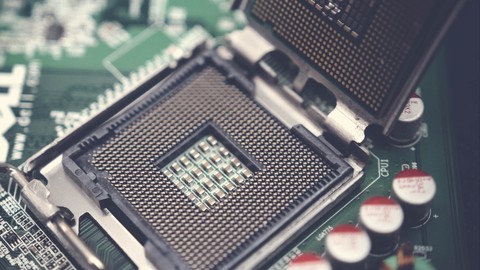
Advanced Microprocessors – 80386 and Pentium Processor
Advanced Microprocessors – 80386 and Pentium Processor, available at $44.99, with 32 lectures, 6 quizzes, and has 3 subscribers.
You will learn about Features of 80386 Microprocessor Modes of 80386 Microprocessor Real and Protected mode of 80386 Microprocessor Programming Model of 80386 Microprocessor Address Translation Mechanism of 80386 Microprocessor Segment Descriptor of 80386 Microprocessor GDT and LDT concept of 80386 Microprocessor Paging, Protection and Multitasking of 80386 Microprocessor Features and Architecture of 80386 Microprocessor Pipelining of Pentium Processor Cache Memory of Pentium Processor Comparison of Core i3, Core i5, & Core i7 Serial communication Protocols This course is ideal for individuals who are Students (Engineering, Diploma, Science) or Hardware Engineers or Tech Enthusiasts or Embedded Systems Engineers or For those interested in delving deeper into the field of microprocessors or Industry Professional It is particularly useful for Students (Engineering, Diploma, Science) or Hardware Engineers or Tech Enthusiasts or Embedded Systems Engineers or For those interested in delving deeper into the field of microprocessors or Industry Professional.
Enroll now: Advanced Microprocessors – 80386 and Pentium Processor
Summary
Title: Advanced Microprocessors – 80386 and Pentium Processor
Price: $44.99
Number of Lectures: 32
Number of Quizzes: 6
Number of Published Lectures: 32
Number of Published Quizzes: 6
Number of Curriculum Items: 38
Number of Published Curriculum Objects: 38
Original Price: ₹2,999
Quality Status: approved
Status: Live
What You Will Learn
- Features of 80386 Microprocessor
- Modes of 80386 Microprocessor
- Real and Protected mode of 80386 Microprocessor
- Programming Model of 80386 Microprocessor
- Address Translation Mechanism of 80386 Microprocessor
- Segment Descriptor of 80386 Microprocessor
- GDT and LDT concept of 80386 Microprocessor
- Paging, Protection and Multitasking of 80386 Microprocessor
- Features and Architecture of 80386 Microprocessor
- Pipelining of Pentium Processor
- Cache Memory of Pentium Processor
- Comparison of Core i3, Core i5, & Core i7
- Serial communication Protocols
Who Should Attend
- Students (Engineering, Diploma, Science)
- Hardware Engineers
- Tech Enthusiasts
- Embedded Systems Engineers
- For those interested in delving deeper into the field of microprocessors
- Industry Professional
Target Audiences
- Students (Engineering, Diploma, Science)
- Hardware Engineers
- Tech Enthusiasts
- Embedded Systems Engineers
- For those interested in delving deeper into the field of microprocessors
- Industry Professional
Processors serve as the brains of computing devices, executing instructions and carrying out tasks swiftly and efficiently. Their architecture and capabilities shape the performance and functionality of electronic devices, influencing everything from basic operations to complex computations.
Prof. Hitesh Dholakiya is an Electronics and Communication Design Engineerwith over 15 years of experience in the core Electronics/Electrical domain as well as in the Antenna/RF/Communication field. He has taught many subjects related to different Microprocessors and Embedded systems during his tenure of teaching. With a passion for teaching and a wealth of industry knowledge, Prof. Hitesh Dholakiya is dedicated to helping students achieve their academic and professional goals in the Microprocessordomain.
This specialized Advanced Microprocessor course delves into Intel’s 80386 and Pentium processors, catering to students seeking a profound understanding of general-purpose microprocessors and contemporary terminology. Ideal for aspiring professionals, students, and working individuals, this unique Advanced Microprocessorcoursecovers fundamental to intricate microprocessor concepts, ensuring adeptness in comprehending high-end architectures.
This course on Advanced Microprocessorcovers the following topics.
1. 80386 Microprocessor Basics
2. Modes of 80386 Microprocessor
3. GDT, LDT, and Address Translation Mechanism of 80386 Microprocessor
4. Paging, Protection, and Multitasking Mechanism of 80386 Microprocessor
5. Features and Architecture of Pentium Processor
6. Pipelining, Branch Prediction, and Cache Memory Concept in Pentium Processor
7. Comparision of Core I3, Core I5 and Core I7 Processor
8. Serial Communication Protocol
Topic wise Detailed Syllabus of Advanced Microprocessors – 80386 and Pentium Processor is as follows:
1. 80386 Microprocessor Basics:
Feature of Microprocessor 80386, Block Diagram, Flag Registers of 80386 Microprocessor, Programming Model and Control Registers of 80386
2. Modes of 80386 Microprocessor:
Modes of operation of 80386 Microprocessor, Comparison of Real Mode & Protected Mode
3. GDT, LDT, and Address Translation Mechanism of 80386 Microprocessor:
Global Descriptive Table, Local Descriptive Table and Address Translation Mechanism
4. Paging, Protection, and Multitasking Mechanism of 80386 Microprocessor:
Paging, Protection and Multitasking Mechanism of 80386 Microprocessor
5. Features and Architecture of Pentium Processor:
Pentium Processor features and its architecture
6. Pipelining, Branch Prediction, and Cache Memory Concept in Pentium Processor:
Pipelining in Pentium Microprocessor, Branch Prediction Logic in Pentium Microprocessor, Cache Memory in Pentium Microprocessor
7. Comparision of Core I3, Core I5 and Core I7 Processor:
Comparison of Core I3 Core I5 & Core I7
8. Serial Communication Protocol:
I2C, SPI, RS 232, USB, UART Protocols
This Advanced Microprocessorcourse equips learners with a holistic understanding of microprocessor intricacies. By navigating through the Advanced Microprocessorcourse sequentially, participants gain profound insights into advanced microprocessor terminologies, ensuring a robust grasp of higher-end architectures. Designed to cater comprehensively to engineering, science, and diploma branches, this course offers a holistic understanding of microprocessors, making it suitable for a diverse range of learners.
Enroll now and take the first step toward mastering Advanced Microprocessorcore concepts! Join Our Community of students who have transformed their careers with our expert-led course on Advanced Microprocessor!
See you in the Advanced Microprocessors-80386 and Pentiumcourse! You’re going to love it!
Thank You…
Course Curriculum
Chapter 1: Advanced Microprocessors Course Introduction
Lecture 1: Introduction
Lecture 2: Course Trailer
Lecture 3: How to access the course materials
Chapter 2: 80386 Microprocessor Basics
Lecture 1: Feature of Microprocessor 80386
Lecture 2: Block Diagram of Microprocessor 80386
Lecture 3: Flag Register of Microprocessor 80386
Lecture 4: Programming Model of 80386
Lecture 5: Control Registers of 80386
Chapter 3: Modes of 80386 Microprocessor
Lecture 1: Modes of Microprocessor 80386
Lecture 2: Comparison of Real Mode & Protected Mode
Chapter 4: GDT, LDT and Address Translation Mechanism of 80386 Microprocessor
Lecture 1: Address Translation Mechanism
Lecture 2: Segment Descriptor of Microprocessor 80386
Lecture 3: GDT of Microprocessor 80386
Lecture 4: LDT of Microprocessor 80386
Chapter 5: Paging, Protection and Multitasking Mechanism of 80386 Microprocessor
Lecture 1: Paging of Microprocessor 80386
Lecture 2: Protection Mechanism of Microprocessor 80386
Lecture 3: Multitasking of Microprocessor 80386
Chapter 6: Features and Architecture of Pentium Processor
Lecture 1: Features of Pentium Microprocessor
Lecture 2: Architecture of Pentium Microprocessor
Chapter 7: Pipelining, Branch Prediction and Cache Memory Concept in Pentium Processor
Lecture 1: Pipelining in Pentium Microprocessor
Lecture 2: Branch Prediction Logic in Pentium Microprocessor
Lecture 3: Cache Memory in Pentium Microprocessor
Chapter 8: Comparision of Core I3, Core I5 and Core I7 Processor
Lecture 1: Comparison of Core I3 Core I5 & Core I7
Chapter 9: Serial Communication Protocol
Lecture 1: I2C
Lecture 2: SPI
Lecture 3: I2C Vs SPI
Lecture 4: UART
Lecture 5: USB
Lecture 6: RS 232
Lecture 7: Microprocessor Question Bank with Answer
Lecture 8: Feedback
Chapter 10: About our other Courses on Udemy
Lecture 1: Courses on Udemy
Instructors
-

Hitesh Dholakiya
Study Simplified
Rating Distribution
- 1 stars: 0 votes
- 2 stars: 0 votes
- 3 stars: 0 votes
- 4 stars: 0 votes
- 5 stars: 0 votes
Frequently Asked Questions
How long do I have access to the course materials?
You can view and review the lecture materials indefinitely, like an on-demand channel.
Can I take my courses with me wherever I go?
Definitely! If you have an internet connection, courses on Udemy are available on any device at any time. If you don’t have an internet connection, some instructors also let their students download course lectures. That’s up to the instructor though, so make sure you get on their good side!
You may also like
- Digital Marketing Foundation Course
- Google Shopping Ads Digital Marketing Course
- Multi Cloud Infrastructure for beginners
- Master Lead Generation: Grow Subscribers & Sales with Popups
- Complete Copywriting System : write to sell with ease
- Product Positioning Masterclass: Unlock Market Traction
- How to Promote Your Webinar and Get More Attendees?
- Digital Marketing Courses
- Create music with Artificial Intelligence in this new market
- Create CONVERTING UGC Content So Brands Will Pay You More
- Podcast: The top 8 ways to monetize by Podcasting
- TikTok Marketing Mastery: Learn to Grow & Go Viral
- Free Digital Marketing Basics Course in Hindi
- MailChimp Free Mailing Lists: MailChimp Email Marketing
- Automate Digital Marketing & Social Media with Generative AI
- Google Ads MasterClass – All Advanced Features
- Online Course Creator: Create & Sell Online Courses Today!
- Introduction to SEO – Basic Principles of SEO
- Affiliate Marketing For Beginners: Go From Novice To Pro
- Effective Website Planning Made Simple




















